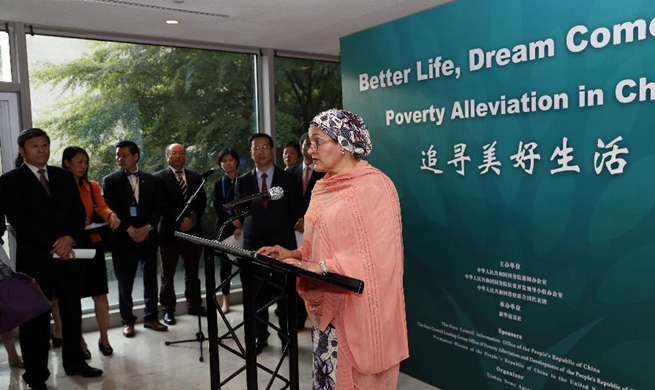by Xinhua writers Lou Chen, Lyu Xueli, Luo Xiaofei
XINING, June 30 (Xinhua) -- China has set a new world record in the plateau province of Qinghai -- 6 million people used only clean energy for nine consecutive days, a testament to China's commitment to clean energy and a low-carbon future.
The trial lasted from June 20 to midnight of June 28 in Qinghai, which borders Tibet Autonomous Region. During the 216 hours, the province ran solely on electricity generated from wind, solar and hydro power stations.
This is the second province-wide clean energy trial in Qinghai. In June last year, it relied solely on renewable energy for seven consecutive days, beating Portugal's 107-hour clean energy efforts in May 2016.
According to China State Grid's Qinghai branch, electricity consumption during the nine days totaled 1.76 billion kilowatt hours, equivalent to coal use of 800,000 tonnes, cutting emission of 1.44 million tonnes of carbon dioxide (CO2).
China is spearheading the global fight against climate change by enforcing strong environmental policies. According to China's commitment in the Paris Agreement, it will cut carbon emissions per unit of GDP by 60-65 percent by 2030 from 2005 levels.
Qinghai's efforts represent a shift across the nation towards low-carbon energy use. During the nine-day period, hydropower stations supplied around 80 percent of power with the rest produced by solar and wind energy, said Qi Taiyuan, general manager of State Grid Qinghai Electric Company.
Around 3 percent of power was generated by coal-fired plants and transmitted to neighboring province Gansu, Qi said. A minimum amount of coal-fired power plants were kept running because they were needed to stabilize grids in time of fluctuations and avoid damage to power infrastructure, he explained.
"During the nine days, we achieved zero emissions in power use in Qinghai," said Xu Yourui, director of coordination center of the company.
Located at the source of China's three major rivers, the Yellow, Yangtze and Lancang, Qinghai has abundant hydro- and solar-power facilities. "Environmental protection is critical in Qinghai because of the river sources. There is strong reason for China to cut emissions in Qinghai, promote clean energy and maximize the efficiency of clean energy facilities," said Qi.
TRANSITION TO LOW CARBON
China has taken monumental strides to reduce reliance on fossil fuels, upgrade its energy structure and improve air quality.
Its enthusiasm for clean energy is pushing the global transition toward a low-carbon future.
The country plans to invest 2.5 trillion yuan (about 370 billion U.S. dollars) in renewable energy by 2020, creating more than 13 million jobs, according to the National Energy Administration.
The country's total installed renewable energy capacity reached 650 million kilowatts in 2017, up 14 percent from 2016. Clean energy generated 1.7 trillion kilowatt hours of electricity last year, accounting for 26.4 percent of the country's total.
In Qinghai, more than 85 percent of the installed power capacity comes from non-fossil fuels.
"Qinghai started developing its new energy industry in 2009, and the rapid expansion has served people well while attaining sustainable growth," said Zhang Hongping, an official of the Qinghai grid.
Stable power supply was extended to about half a million people over the last eight years. People living in remote high-altitude areas did not have access to electricity until three years ago.
Madoi County, located at the source of the Yellow River, 4,500 meters above sea level, requires heating 11 months out of the year; temperatures are low even in June. A campaign was launched in 2017 to replace coal heaters with electric ones in Madoi, where 10,000 people live.
Yumtan Gyatso, a bank official in Madoi County, said his bank used 300 tonnes of coal for heating every year and now, their heaters are powered by electricity, a much cleaner alternative.
For Qinghai's energy guzzlers such as China Aluminum Corporation's Qinghai subsidiary, emission reduction is impressive. The aluminum producer uses a whopping 15 million kilowatt hours of electricity every day to produce 1,000 tonnes of aluminum products.
During the nine days, it cut CO2 emission by 5,700 tonnes, said Xing Zhanxiong, general manager of the company.
"The significance of the 9-day green energy operation is not only in the emission figures. It signals the direction we should be heading, which is green and low-emissions," Xing said.
In February this year, the National Energy Administration approved six provincial-level regions including Qinghai, Zhejiang, Sichuan, Tibet, Gansu and Ningxia to spearhead clean energy development.
Qinghai plans to expand its solar and wind capacity to 20 million kilowatts by 2020. "Qinghai will explore possibilities to run solely on renewable energy for one month or an even longer period," said Qi Taiyuan.
With the improvement of energy storage technology and better coordination of power suppliers, it is possible to rely 100 percent on non-fossil fuels in the future, he said.
(Xinhua reporter Deng Wanli contributed to the story.)

















